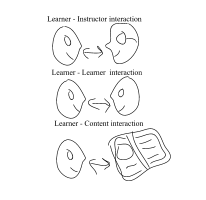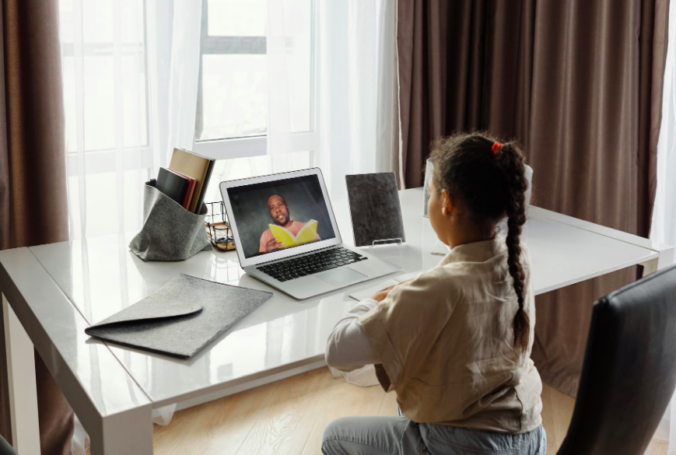“We are social beings… this fact is a central aspect of learning”
(Garrett Dickers, 2018)

Before entering this course and learning more from the course resources and handouts, my knowledge of the importance of interactions and relationships within a K-12 classroom was purely from personal experience. It is clear being both a student and a teacher how much of a difference the relationships amongst your students, their peer and you can make in personal learning, however, what was revolutionary to me was how these different relationships work differently to promote learning.
While taking notes throughout the two readings a lot of familiar theories were brought up, starting with Vygotsky and his theory of Social Development. This theory states that students learn best when they work within their Zone of proximal development (Garett Dickers, 2018). This theory has been talked a lot within the educational community and can be explained by what a student can accomplish on their own compared to what they can eventually achieve with the assistance of peers, instructors, and with a deeper understanding. What never occurred to me however was how the Zone of Proximal Development proves the statement that learning, and conceptualizing occurs at a greater level through interaction and collaboration (what the learner can achieve with the help from peers and teachers).

Learning-Instructor interaction ^ in educational value
Learner-Learner interaction ^ in educational value
^ in motivational value
Learner-content interaction ^ in educational value
During the readings, I couldn’t help but reflect on my time as an online student. In Dicker’s article, there is a point where he states the barriers that come alongside online learning: Lack of communication with peers, impersonal nature of online learning, fear of isolation, lack of social context, and lack of student collaboration, and honestly, I could relate to each of these barriers and how negatively they affected me within the past four months. To spare the sad details of my stressful times while being involved in an online learning platform, stated plainly, it is so important that we as teachers learn to be able to express the same level of relationships, we do in a face-to-face classroom on an online platform.
“Learning is social, learning is active, learning is interactive”
(Garett Dickers, 2018)

Garrett Dicker’s article gives solutions and tools for what teachers can do to build these virtual relationships with their students while still promoting a safe and engaging learning environment. In the age of having so many optional online tools teachers can use programs and software to create learning spaces that can be arguably just as interactive, collaborative, and motivating as the classroom. As the article explains, these online spaces are so important to students on levels deeper than their content, these online spaces are the key to keeping children motivated in their learning. Creating a social presence is the key to creating the classroom community (Dickers, 2018) and can be done through social media platforms such as Zoom, Facebook, Twitter, etc. These social spaces also give teachers the chance to create meaningful one-on-one relationships with each student to aid in their own personal learning and to facilitate a trusting community. Teachers can show their engagement with their students by:
-
- Designing and organizing learning activities;
- Facilitating discourse with students, parents, and other teachers;
- Providing students with one-on-one instruction;
- Nurturing a safe and caring learning environment;
- Motivating students to engage in learning activities; and
- Closely monitoring student behavior and learning
(Garrett Dickers, 2018)
Topic one has forced me to reflect upon the importance of creating meaningful relationships and how I can create them myself with others. It is alarming the difference us humans are in reality than how we come across online, and I can see in everyday situations how relationships, communication, and even personal attributes can abruptly change across both. This “change” I wish to learn more about and how to control/rid the stigma on “hiding behind the computer screen”. It frustrates me and scares me knowing that people feel safer and stronger sharing negative or fake emotions when virtual versus face-to-face, and this worries me when it comes to creating meaningful interactions and relationships in an online learning platform.
References:
Garrett Dickers, A. (2018) Social Interaction in K-12 Online Learning. In R. Ferdig & K. Kennedy (Eds.), Handbook of research on K-12 online and blended learning (pp. 509-522 ). Pittsburgh, PA: Carnegie Mellon University ETC Press.

Kirby Jarvis, the quote at the top of your post is excellent, I never considered to do this, and I will surely use it in the future. The way you began your blog post with a personal experience reminds me of the relationship-building advice we received during the webinar with Dr. Brown. Furthermore, your brief explanation of Vygotsky would help someone outside the faculty of education who may be reading your work. I wish I had thought to do this. The illustrations you used created a classroom-like atmosphere, and as I read your post, I thought, “a teacher wrote this.” By concluding with a connection and a real-world concern, you furthered the feeling of being connected to the author (you). Did you intentionally write this as an example of what we learned in this unit? I suspect, yes, you did, and it was a borderline genius strategy.
Great post! I learned from it, and I feel it will act as a mentor text for my blog posts in the future. Great work, and you are the perfect person to become a teacher!
Great blog post Kirby! First of all, I really liked the layout of your post – the bolded and isolated quotes, related images and general flow of your writing made it super engaging and visually pleasing to read. Your writing style is just the perfect mix of personable and professional which is perfect for this blog format! Adding on, I liked how you both highlighted the necessity and advantages associated with creating connections and a social presence as well as the negative consequences that could occur if social interactions are not supported or neglected all together – doing so helped with emphasizing the foundational nature of building relationships and classroom community. As well, I appreciated how you incorporated your personal experiences surrounding building meaningful relationships and participating in online learning. By explaining how working through the readings and resources explored in topic one led you to reflect more deeply about your opinions regarding facilitating effective communication and collaboration in virtual learning spaces and what you want to learn further, you demonstrated strong reflective skills which are important (and, in my opinion, essential) for teachers to have and exercise often!
I look forward to reading more of your posts! 🙂